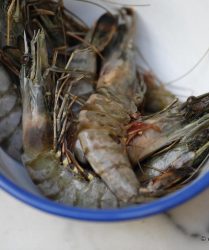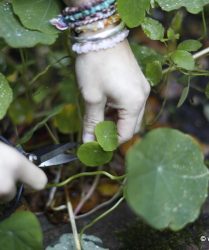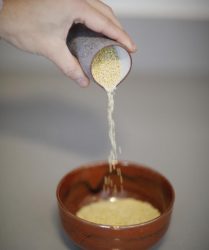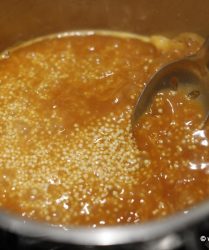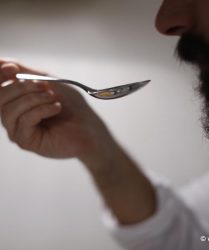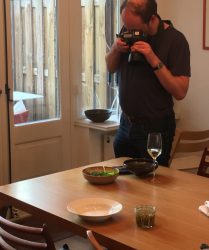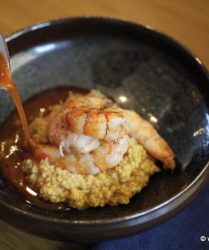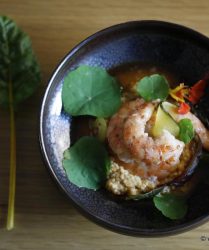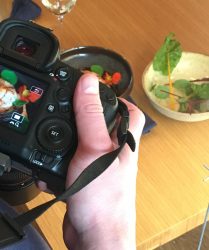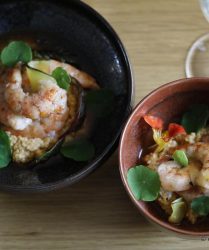True Grits is
the second column from the series DISH!
–
I have forever been fascinated by the forces that drive the creation and evolution of local cuisines, the food of the people. Some of these are practical and driven by what fruits the land bears. Peasant food in the south of Italy is rich in fish, raisins, olive oil because this is what is available. Drive a few hours north and richer pastures make space for butter to make an appearance. Other forces are cultural and heavily influenced by migratory patterns and the family trees of the people inhabiting the lands.
I find it an interesting exercise to reimagine what our food would be like if the cultural forces had been different, rooted elsewhere. This recipe is the product of such an exercise, seeing the grain that grows abundantly in the Dutch plains and the seafood teeming outside the coastline surrounding them from a different perspective. How would shrimp and grits, a staple in the Deep South of the United States, look if, instead of their native corn, it was based on Dutch grains, such as millet?
As an appetiser for four, we need 8 very large fresh prawns, or 12 large ones, about 400gr in total. Remove the shells and head and set them aside. Clean and discard the black line that runs through each prawn, but keep the tails as intact and beautiful as possible.
Much of the taste of these crustaceans hides inside their shells and heads; we can harness this by preparing a rich shrimp stock for the millet. In a large saucepan, add two tablespoons of olive oil and sweat a small diced onion over medium heat, until soft. Add the reserved shells and heads,
turn the heat up to medium high, and roast the shells until they have changed in colour, all the while crushing them with the back of a spoon so they give up their secrets. Add a teaspoon each of fennel seeds and paprika, half a teaspoon of ground coriander, two small pinches of cumin, and a generous tablespoon of tomato purée. Toast the mixture for a few minutes until it is beginning to caramelise and deglaze with half a cup of white wine. After much of the liquid has evaporated, add 750ml of water, a teaspoon of salt, and a tablespoon of fish sauce. Bring to the boil and simmer gently for 45 minutes, to obtain a rich stock. Drain through a fine sieve into a clean saucepan, pressing all solids so nothing is wasted.
To the simmering stock, add 200gr of millet and stir vigorously for a minute, then let it simmer for about 15 minutes, stirring occasionally so it becomes creamy and soft. The consistency you are looking for is that of soft polenta. While the millet is cooking, add the shrimp tails in a saucepan that will fit them snugly, along with a teaspoon of ras el hanout (a north African spice blend) and enough melted butter to cover them entirely. Weigh them with a small saucer and let them poach on very low heat for 5-8 minutes, depending on their size. When the millet is cooked, beat in two tablespoons of crème fraiche and 4-5 drops of cider vinegar, to a creamy consistency.
To assemble, divide the millet into four warmed deep plates, and garnish with a few pickled vegetables, such as radishes, carrots, courgettes, etc. Top with the poached shrimp tails, a dusting of ras el hanout, and garnish with peppery greens, and a few drops of the poaching butter.
TEXT TASSOS SARAMPALIS | PHOTOGRAPHY SANDER MARTENS
DISH is the brainchild of two friends, Sander Martens and Tassos Sarampalis. Though they come from very different parts of the world, they are both inspired by food; Sander as a photographer and Tassos as food writer. Together, they explore the taste and nature of food, visually, culturally, and artistically, influenced by their international and local experiences. The column is published every two months in Villa d’Arte (Kookkunst).
© Sander Martens & Tassos Sarampalis, all rights reserved

